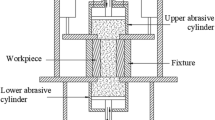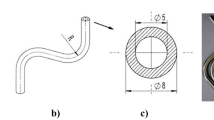Abstract
The investigation was carried out on the technical problems of finishing the inner surface of elbow parts and the action mechanism of particles in elbow precision machining by abrasive flow. This work was analyzed and researched by combining theory, numerical and experimental methods. The direct simulation Monte Carlo (DSMC) method and the finite element analysis method were combined to reveal the random collision of particles during the precision machining of abrasive flow. Under different inlet velocity, volume fraction and abrasive particle size, the dynamic pressure and turbulence flow energy of abrasive flow in elbow were analyzed, and the machining mechanism of particles on the wall and the influence of different machining parameters on the precision machining quality of abrasive flow were obtained. The test results show the order of the influence of different parameters on the quality of abrasive flow precision machining and establish the optimal process parameters. The results of the surface morphology before and after the precision machining of the inner surface of the elbow are discussed, and the surface roughness Ra value is reduced from 1.125 µm to 0.295 µm after the precision machining of the abrasive flow. The application of DSMC method provides special insights for the development of abrasive flow technology.
摘要
针对弯管类零件内表面精加工技术难题以及磨粒流精密加工弯管中颗粒的作用机制展开了研 究. 通过结合理论分析、 数值和试验的方法进行分析研究. 将直接模拟蒙特卡罗方法与有限元分析方法结合揭示磨粒流精密加工过程中颗粒的随机碰撞, 在不同的磨粒流入口速度、 体积分数以及磨粒粒径下, 对弯管中磨粒流的动态压强、 湍流动能分析得出了颗粒对壁面的加工机理以及不同加工参数对磨粒流精密加工质量的影响规律. 试验结果展示了不同参数对磨粒流精密加工质量的影响顺序并建立了最优工艺参数. 讨论了弯管内表面磨粒流精密加工前后的有关表面形态的结果, 而且经过磨粒流精密加工后表面粗糙度Ra 值由 1.125 μm 降低到了 0.295 μm. 直接模拟蒙特卡罗方法的应用为磨粒流技术的发展提供参考.
Similar content being viewed by others
References
FU You-zhi, WANG Xuan-ping, GAO Hang, WEI Hai-bo, LI Shi-chong. Blade surface uniformity of blisk finished by abrasive flow machining [J]. International Journal of Advanced Manufacturing Technology, 2016, 84: 1725–1735. DOI: https://doi.org/10.1007/s00170-020-05589-z.
BARAIYA R, BABBAR A, JAIN V, GUPTA D. In-situ simultaneous surface finishing using abrasive flow machining via novel fixture [J]. Journal of Manufacturing Processes, 2020, 50: 266–278. DOI: https://doi.org/10.1016/j.jmapro.2019.12.051.
SHAO Y, CHENG K. Integrated modelling and analysis of micro-cutting mechanics with the precision surface generation in abrasive flow machining [J]. International Journal of Advanced Manufacturing Technology, 2019, 105(11): 4571–4583. DOI: https://doi.org/10.1007/s00170-019-03595-4.
ZHAO Jun, HUANG Jin-feng, WANG Rui, PENG Hao-ran, HANG Wei, JI Shi-ming. Investigation of the optimal parameters for the surface finish of K9 optical glass using a soft abrasive rotary flow polishing process [J]. Journal of Manufacturing Processes, 2020, 49: 26–34. DOI: https://doi.org/10.1016/j.jmapro.2019.11.011.
GE Jiang-qin, JI Shi-ming, TAN Da-peng. A gas-liquid-solid three-phase abrasive flow processing method based on bubble collapsing [J]. International Journal of Advanced Manufacturing Technology, 2018, 95(1–4): 1069–1085. DOI: https://doi.org/10.1007/s00170-017-1250-9.
CHEN Feng-jun, HAO Shan-mei, MIAO Xiang-liang, YIN Shao-hui, HUANG Shuai. Numerical and experimental study on low-pressure abrasive flow polishing of rectangular microgroove [J]. Powder Technology, 2018, 327: 215–222. DOI: https://doi.org/10.1016/j.powtec.2017.12.062.
CHERIAN J, ISSAC J M. Fatigue performance in abrasive flow machining [J]. Applied Mechanics & Materials, 2014, 592–594: 354–362. DOI: https://doi.org/10.4028/www.scientific.net/AMM.592-594.354.
CHERIAN J, ISSAC J M. Effect of process parameters on wear performance in abrasive flow machining [J]. Applied Mechanics & Materials, 2015, 766–767: 661–667. DOI: https://doi.org/10.4028/www.scientific.net/AMM.766-767.661.
SUSHIL M, VINOD M, HARMESH M. Multi-objective optimization of process parameters involved in micro-finishing of Al/SiC MMCs by abrasive flow machining process [J]. Proc IMechE Part L: J Materials: Design and Application, 2018, 232: 319–332. DOI: https://doi.org/10.1177/1464420715627292.
LI Jun-ye, MENG Wen-qing, DONG Kun, ZHANG Xin-ming, ZHAO Wei-hong. Study of Effect of Impacting Direction on Abrasive Nanometric Cutting Process with Molecular Dynamics [J]. Nanoscale Research Letters, 2018, 13(1): 11. DOI: https://doi.org/10.1186/s11671-017-2412-2.
LI Jun-ye, ZHANG Heng-fu, WEI Li-li, ZHANG Xin-ming, XU Ying, XU Cheng-yu. Formation mechanism and quality control technology for abrasive flow precision polishing vortex: large eddy simulation [J]. International Journal of Advanced Manufacturing Technology, 2019, 105(5–8): 2135–2150. DOI: https://doi.org/10.1007/s00170-019-04232-w.
JI Shi-ming, TANG Bo, TAN Da-peng, GONG Bin, YUAN Qiao-ling, PAN Yan. Structured surface softness abrasive flow precision finish machining and its abrasive flow dynamic numerical analysis [J]. Journal of Mechanical Engineering, 2010, 46: 178–184. DOI: https://doi.org/10.3901/JME.2010.15.178. (in Chinese)
TAN Da-peng, JI Shi-ming, FU You-zhi. An improved soft abrasive flow finishing method based on fluid collision theory [J]. International Journal of Advanced Manufacturing Technology, 2016, 85(5–8): 1261–1274. DOI: https://doi.org/10.1007/s00170-015-8044-8
PAN Ye, JI Shi-ming, TAN Da-peng, CAO Hui-qiang. Cavitation-based soft abrasive flow processing method [J]. International Journal of Advanced Manufacturing Technology, 2020, 109: 2587–2602. DOI: https://doi.org/10.1007/s00170-020-05836-3.
SANKAR M R, JAIN V K, RAMKUMAR J, SAREEN S K, SINGH S. Medium rheological characterization and performance study during rotational abrasive flow finishing (R-AFF) of Al alloy and Al alloy/SiC MMCs [J]. The International Journal of Advanced Manufacturing Technology, 2018, 100(5–8): 1149–1163. DOI: https://doi.org/10.1007/s00170-018-2244-y.
SINGH S, RAJ A S A, SANKAR M R, JAIN V K. Finishing force analysis and simulation of nanosurface roughness in abrasive flow finishing process using medium rheological properties [J]. Int J Adv Manuf Technol, 2016, 85: 2163–2178. DOI: https://doi.org/10.1007/s00170-015-8333-2.
PETARE A C, MISHRA A, PALANI I A, JAIN N K. Study of laser texturing assisted abrasive flow finishing for enhancing surface quality and microgeometry of spur gears [J]. International Journal of Advanced Manufacturing Technology, 2019, 101: 785–799. DOI: https://doi.org/10.1007/s00170-018-2944-3.
MAIRE S, TALAY A D. On a Monte Carlo method for neutron transport criticality computations [J]. IMA Journal of Numerical Analysis, 2006, 26(4): 657–685. DOI: https://doi.org/10.1093/imanum/drl008.
CHUNG M H, CHANG C H, CHANG K Y, WU Y S, GAO S F, SHEN Z P. A framework for train derailment risk analysis [J]. Journal of Central South University, 2019, 26: 1874–1885. DOI: https://doi.org/10.1007/s11771-019-4141-4.
LI T, DIAS D. Tunnel face reliability analysis using active learning Kriging model-Case of a two-layer soils [J]. Journal of Central South University, 2019, 26(7): 1735–1746. DOI: https://doi.org/10.1007/s11771-019-4129-0.
GAO H F, BAI G C, GAO Y, BAO T W. Reliability analysis for aeroengine turbine disc fatigue life with multiple random variables based on distributed collaborative response surface method [J]. Journal of Central South University, 2015, 22(12): 4693–4701. DOI: https://doi.org/10.1007/s11771-015-3020-x.
PÉREZ-CASTÁN J A, GÓMEZ COMENDADOR F, RODRÍGUEZ-SANZ Á, ARNALDO VALDÉS R M, ALONSO-ALARCON J F. Safe RPAS integration in non-segregated airspace [J]. Aircraft Engineering and Aerospace Technology, 2020, 92(6): 801–806. DOI: https://doi.org/10.1108/AEAT-11-2019-0224.
ROMANO M, LOSACCO M, COLOMBO C, LIZIA P. Impact probability computation of near-Earth objects using Monte Carlo line sampling and subset simulation [J]. Celest Mech Dyn Astr, 2020, 132(8): 42. DOI: https://doi.org/10.1007/s10569-020-09981-5.
MOZAFFARI M S, ROOHI E. On the thermally-driven gas flow through divergent micro/nanochannels [J]. International Journal of Modern Physics C, 2017, 28(12): 1750143. DOI: https://doi.org/10.1142/S0129183117501431.
ÖZTÜRK S, KAHRAMAN M F. Modeling and optimization of machining parameters during grinding of flat glass using response surface methodology and probabilistic uncertainty analysis based on Monte Carlo simulation [J]. Measurement, 2019, 145: 274–291. DOI: https://doi.org/10.1016/j.measurement.2019.05.098.
KAHRAMAN M F, ÖZTÜRK S. Experimental study of newly structural design grinding wheel considering response surface optimization and Monte Carlo simulation [J]. Measurement, 2019, 147: 106825. DOI: https://doi.org/10.1016/j.measurement.2019.07.053.
DU Min, ZHAO Chang-sui, ZHOU Bin, GUO Hong-wei, HAO Ying-li. A modified DSMC method for simulating gas-particle two-phase impinging streams [J]. Chemical Engineering Science, 2011, 66(20): 4922–4931. DOI: https://doi.org/10.1016/j.ces.2011.06.061.
WAGNER W. A convergence proof of Bird’s direct simulation Monte Carlo method for the Boltzmann equation [J]. Journal of Statistical Physics, 1992, 66: 1011–1044. DOI: https://doi.org/10.1007/BF01055714.
LI Jin, GENG Xiang-ren, CHEN Jian-qiang, JIANG Ding-wu. Novel hybrid hard sphere model for direct simulation Monte Carlo computations [J]. Journal of Thermophysics and Heat Transfer, 2017, 32: 1–5. DOI: https://doi.org/10.2514/1.T5162.
TOMÁŠ TISOVSKÝ, TOMÁŠ VÍT. Direct simulation Monte Carlo method for gas flows in micro-channels with bends with added curvature [J]. EPJ Web of Conferences, 2017, 143: 02131. DOI: https://doi.org/10.1051/epjconf/201714302131.
KITRON A, ELPERIN T, TAMIR A. Monte Carlo simulation of gas-solids suspension flows in impinging streams reactors [J]. International Journal of Multiphase Flow, 1990, 16(1): 1–17. DOI: https://doi.org/10.1016/0301-9322(90)90033-F.
LUN C K K, SAVAGE S B. A simple kinetic theory for granular flow of rough, inelastic, spherical particles [J]. Journal of Applied Mechanics, 1987, 54(1): 47. DOI: https://doi.org/10.1115/1.3172993.
LOWELL L BAKER, NICOLAS G, HADJICONSTANTINOU. Variance-reduced monte carlo solutions of the boltzmann equation for low-speed gas flows: A discontinuous galerkin formulation [J]. International Journal for Numerical Methods in Fluids, 2008, 58(4): 381–402. DOI: https://doi.org/10.1002/fld.1724.
TSUJI, Y, TANAKA, T, YONEMURA, S. Cluster patterns in circulating fluidized beds predicted by numerical simulation [J]. Powder Technology, 1998, 95(3): 254–264. DOI: https://doi.org/10.1016/S0032-5910(97)03349-4.
OESTERLE B, PETITJEAN A. Simulation of particle-to-particle interactions in gas solid flows [J]. International Journal of Multiphase Flow, 1993, 19(1): 199–211. DOI: https://doi.org/10.1016/0301-9322(93)90033-Q.
ILLNER R, NEUNZERT H. On simulation methods for the Boltzmann equation [J]. Transport Theory & Statistical Physics, 1987, 16(2, 3): 141–154. DOI: https://doi.org/10.1080/00411458708204655.
ZHANG Li, WANG Jin-shun, TAN Da-peng, YUAN Zhi-min. Gas compensation-based abrasive flow processing method for complex titanium alloy surfaces [J]. International Journal of Advanced Manufacturing Technology, 2017, 92: 3385–3397. DOI: https://doi.org/10.1007/s00170-017-0400-4.
ZHANG Li, YUAN Zhimin, QI Zijian, CAI Donghai, CHENG Zhichao, QI Huan. CFD-based study of the abrasive flow characteristics within constrained flow passage in polishing of complex titanium alloy surfaces [J]. Powder Technology, 2018, 333: 209–218. DOI: https://doi.org/10.1016/j.powtec.2018.04.046.
LI Chen, XU Qing-duo, GE Jiang-qin, LI Zhi-an, GUO Li-ming. Study of soft abrasive flow field measurement based on particle image velocimetry [J]. Int J Adv Manuf Technol, 2020, 109: 2039–2047. DOI: https://doi.org/10.1007/s00170-020-05765-1.
LI J, JI S, TAN D. Improved soft abrasive flow finishing method based on turbulent kinetic energy enhancing [J]. Chin J Mech Eng, 2017, 30: 301–309. DOI: https://doi.org/10.1007/s10033-017-0071-y.
JI Shi-ming, CAO Hui-qiang, ZHAO Jun, PAN Ye, JIANG En-yong. Soft abrasive flow polishing based on the cavitation effect [J]. Int J Adv Manuf Technol, 2019, 101: 1865–1878. DOI: https://doi.org/10.1007/s00170-018-2983-9.
DING J F, ZHANG K H, XU Y C. Research on grain impacting load in abrasive flow machining [J]. Advanced Materials Research, 2013, 797: 405–410. DOI: https://doi.org/10.4028/www.scientific.net/AMR.797.405.
RHOADES L J. Abrasive flow machining [J]. Manufacturing Engineering, 2016: 75–78. DOI: https://doi.org/10.1007/978-3-319-30198-3_18.
JAIN R K, JAIN V K, DIXIT P M. Modeling of material removal and surface roughness in abrasive flow machining process [J]. International Journal of Machine Tools & Manufacture, 1999, 39(12): 1903–1923. DOI: https://doi.org/10.1016/S0890-6955(99)00038-3.
GORANA V K, JAIN V K, LAL G K. Forces prediction during material deformation in abrasive flow machining [J]. Wear, 2006, 260(1): 128–139. DOI: https://doi.org/10.1016/j.wear.2004.12.038.
KATO K, ADACHI K. Wear mechanisms[M]. Boca Raton: CRC Press, 2000. https://tohoku.pure.elsevier.com/en/publications/wear-mechanisms.
LI Jun-ye, WANG Li-xiong, ZHANG Heng-fu, HU Jing-lei, ZHANG Xin-ming, ZHAO Wei-hong. Mechanism Research and Discussion of the Quality of Precision Machining of a Fifth-order Variable-diameter Pipe Using Abrasive Flow [J]. StrojniŠki Vestnik-Journal of Mechanical Engineering, 2020, 66(6): 358–374. DOI: https://doi.org/10.5545/sv-jme.2020.6554.
Author information
Authors and Affiliations
Contributions
The overarching research goals were developed by LI Jun-ye, ZHU Zhi-bao, and WANG Bin-yu. ZHAO Wei-hong, and XU Cheng-yu carried out abrasive flow machining on the elbow workpiece. The initial draft of the manuscript was written by LI Jun-ye, ZHU Zhi-bao, and WANG Bin-yu. LI Jun-ye, ZHANG Xin-ming, and WANG Fei provided financial support. All authors replied to reviewers’ comments and revised the final version.
Corresponding author
Ethics declarations
LI Jun-ye, ZHU Zhi-bao, WANG Bin-yu, ZHANG Xin-ming, WANG Fei, ZHAO Wei-hong, XU Cheng-yu declare that they have no conflict of interest.
Additional information
Foundation item: Projects(NSFC 51206011, U1937201) supported by the National Natural Science Foundation of China; Project (20200301040RQ) supported by the Science and Technology Development Program of Jilin Province, China; Project(JJKH20190541KJ) supported by the Project of Education Department of Jilin Province, China; Project(18DY017) supported by Changchun Science and Technology Program of Changchun City, China
Rights and permissions
About this article
Cite this article
Li, Jy., Zhu, Zb., Wang, By. et al. Elbow precision machining technology by abrasive flow based on direct Monte Carlo method. J. Cent. South Univ. 27, 3667–3683 (2020). https://doi.org/10.1007/s11771-020-4562-0
Received:
Accepted:
Published:
Issue Date:
DOI: https://doi.org/10.1007/s11771-020-4562-0
Key words
- precision machining by abrasive flow
- direct simulation Monte Carlo method
- abrasive particle collision
- processing technology




